Kuppan T. Heat Exchanger Design Handbook
Подождите немного. Документ загружается.

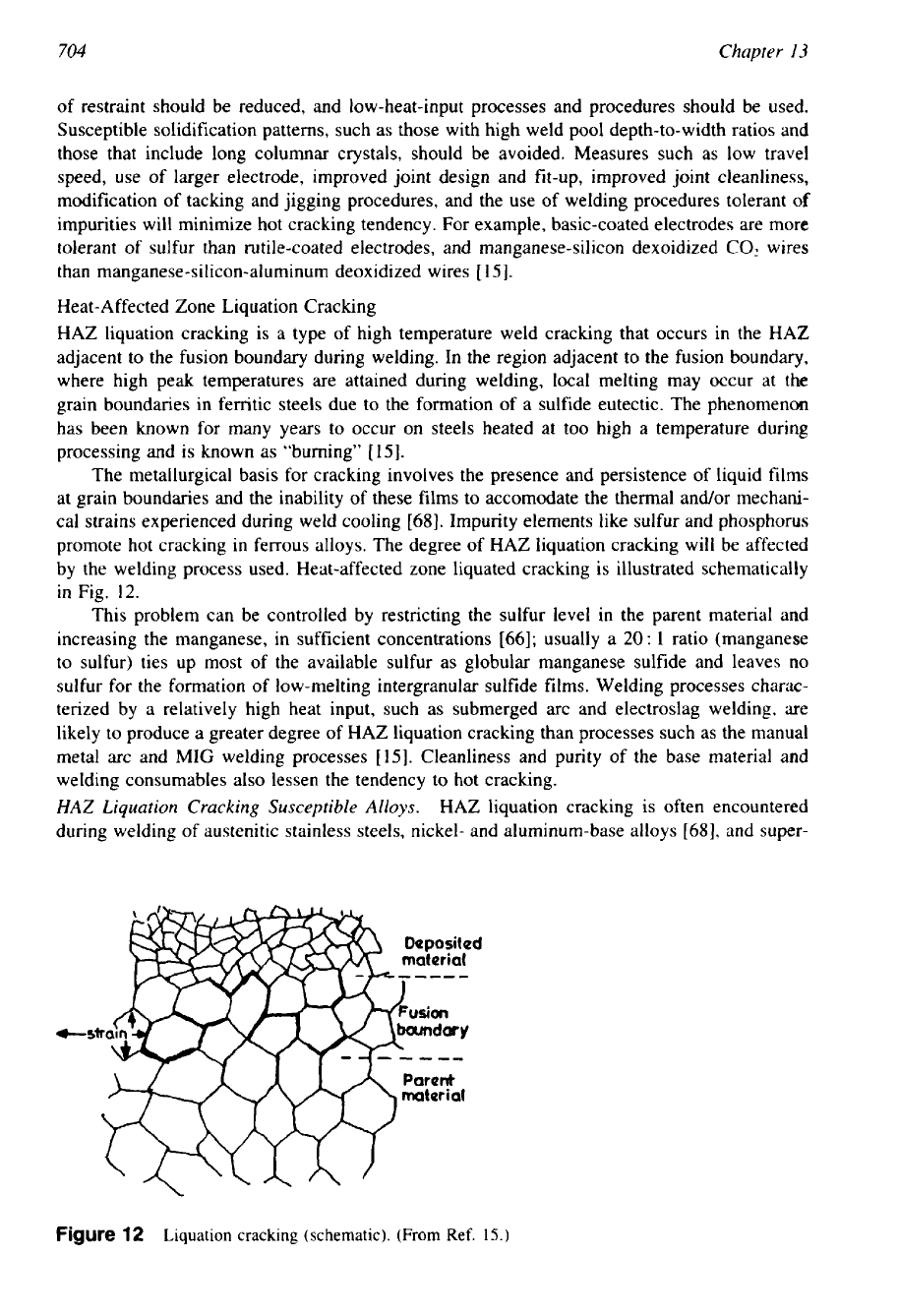
704
Chapter
13
of
restraint should be reduced, and low-heat-input processes and procedures should be used.
Susceptible solidification patterns, such as those with high weld pool depth-to-width ratios and
those that include long columnar crystals, should be avoided. Measures such as low travel
speed, use of larger electrode, improved joint design and fit-up, improved joint cleanliness,
modification of tacking and jigging procedures, and the use of welding procedures tolerant
of
impurities will minimize hot cracking tendency. For example, basic-coated electrodes are more
tolerant
of
sulfur than rutile-coated electrodes, and manganese-silicon dexoidized
COI
wires
than
manganese-silicon-aluminum
deoxidized wires
[
151.
Heat-Affected Zone Liquation Cracking
HAZ liquation cracking is a type of high temperature weld cracking that occurs in the HA2
adjacent
to
the fusion boundary during welding. In the region adjacent
to
the fusion boundary,
where high peak temperatures are attained during welding, local melting may occur at
the
grain boundaries in femtic steels due
to
the formation of a sulfide eutectic. The phenomenon
has been known for many years
to
occur on steels heated at
too
high a temperature during
processing and is known as "burning"
[
151.
The metallurgical basis for cracking involves the presence and persistence of liquid films
at grain boundaries and the inability
of
these films to accomodate the thermal andor mechani-
cal strains experienced during weld cooling
[68].
Impurity elements like sulfur and phosphorus
promote hot cracking
in
ferrous alloys. The degree of
HAZ
liquation cracking will be affected
by the welding process used. Heat-affected zone liquated cracking is illustrated schematically
in
Fig.
12.
This problem can be controlled by restricting the sulfur level in the parent material and
increasing the manganese, in sufficient concentrations
[66];
usually a
20
:
1
ratio (manganese
to
sulfur) ties up most
of
the available sulfur as globular manganese sulfide and leaves
no
sulfur for the formation
of
low-melting intergranular sulfide films. Welding processes charac-
terized by a relatively high heat input, such as submerged arc and electroslag welding, are
likely to produce a greater degree
of
HAZ liquation cracking than processes such as the manual
metal arc and
MIG
welding processes
[IS].
Cleanliness and purity of the base material and
welding consurnables also lessen the tendency to hot cracking.
HAZ
Liqiration Cracking Susceptible Alloys.
HAZ liquation cracking is often encountered
during welding of austenitic stainless steels, nickel- and aluminurn-base alloys
[68].
and super-
Figure
12
Liquation cracking
(schematic).
(From
Ref.
15.)
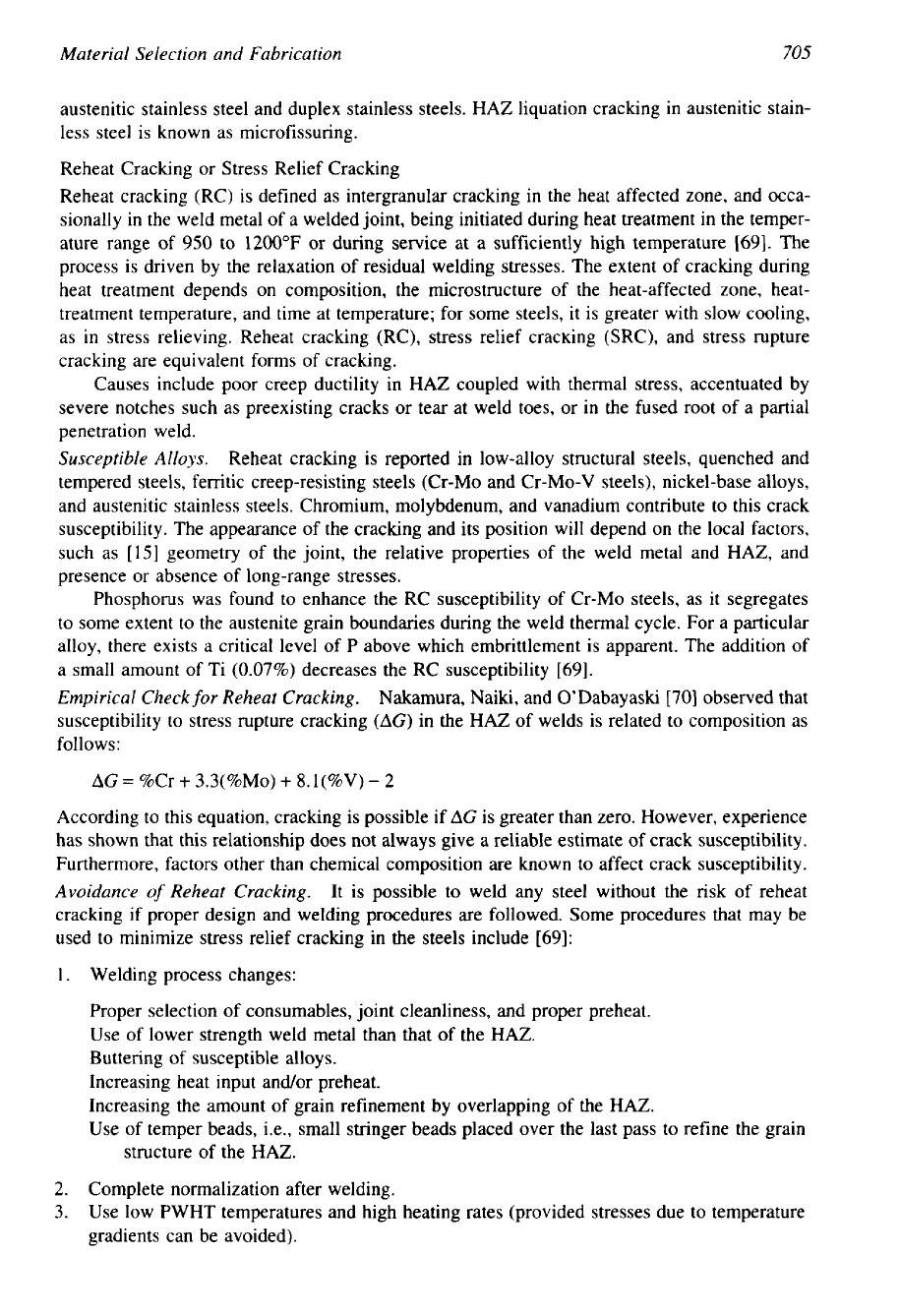
705
Material Selection and Fabrication
austenitic stainless steel and duplex stainless steels. HAZ liquation cracking in austenitic stain-
less steel is known as microfissuring.
Reheat Cracking or Stress Relief Cracking
Reheat cracking (RC) is defined as intergranular cracking in the heat affected zone, and occa-
sionally in the weld metal of a welded joint, being initiated during heat treatment in the temper-
ature range of 950 to
1200°F
or
during service at a sufficiently high temperature [69]. The
process is driven by the relaxation of residual welding stresses. The extent of cracking during
heat treatment depends on composition, the microstructure of the heat-affected zone, heat-
treatment temperature, and time at temperature; for some steels, it is greater with slow cooling,
as in stress relieving. Reheat cracking (RC), stress relief cracking
(SRC),
and stress rupture
cracking are equivalent forms of cracking.
Causes include poor creep ductility in HAZ coupled with thermal stress, accentuated by
severe notches such as preexisting cracks or tear at weld toes, or in the fused root of a partial
penetration weld.
Susceptible AZloys.
Reheat cracking is reported in low-alloy structural steels, quenched and
tempered steels, ferritic creep-resisting steels (Cr-Mo and Cr-Mo-V steels), nickel-base alloys,
and austenitic stainless steels. Chromium, molybdenum, and vanadium contribute to this crack
susceptibility. The appearance of the cracking and its position will depend on the local factors,
such as
[15]
geometry of the joint, the relative properties of the weld metal and HAZ, and
presence or absence of long-range stresses.
Phosphorus was found to enhance the RC susceptibility of Cr-Mo steels, as it segregates
to some extent to the austenite grain boundaries during the weld thermal cycle. For a particular
alloy, there exists a critical level of P above which embrittlement is apparent. The addition of
a small amount of Ti (0.07%) decreases the RC susceptibility [69].
Empirical Check
for
Reheat Cracking.
Nakamura, Naiki, and
0’
Dabayaski [70] observed that
susceptibility to stress rupture cracking
(AG)
in the HA2 of welds is related to composition as
follows:
AG
=
%Cr
+
3.3(%Mo)
+
8.1(%V)
-
2
According to this equation, cracking is possible if
AG
is greater than zero. However, experience
has shown that this relationship does not always give a reliable estimate of crack susceptibility.
Furthermore, factors other than chemical composition are known to affect crack susceptibility.
Avoidance
of
Reheat Cracking.
It is possible to weld any steel without the risk of reheat
cracking if proper design and welding procedures are followed. Some procedures that may be
used to minimize stress relief cracking in the steels include [69]:
Welding process changes:
Proper selection of consumables, joint cleanliness, and proper preheat.
Use of lower strength weld metal than that of the HAZ.
Buttering
of
susceptible alloys.
Increasing heat input and/or preheat.
Increasing the amount of grain refinement by overlapping of the HAZ.
Use of temper beads, i.e., small stringer beads placed over the last pass to refine the grain
structure of the HAZ.
Complete normalization after welding.
Use low PWHT temperatures and high heating rates (provided stresses due to temperature
gradients can be avoided).
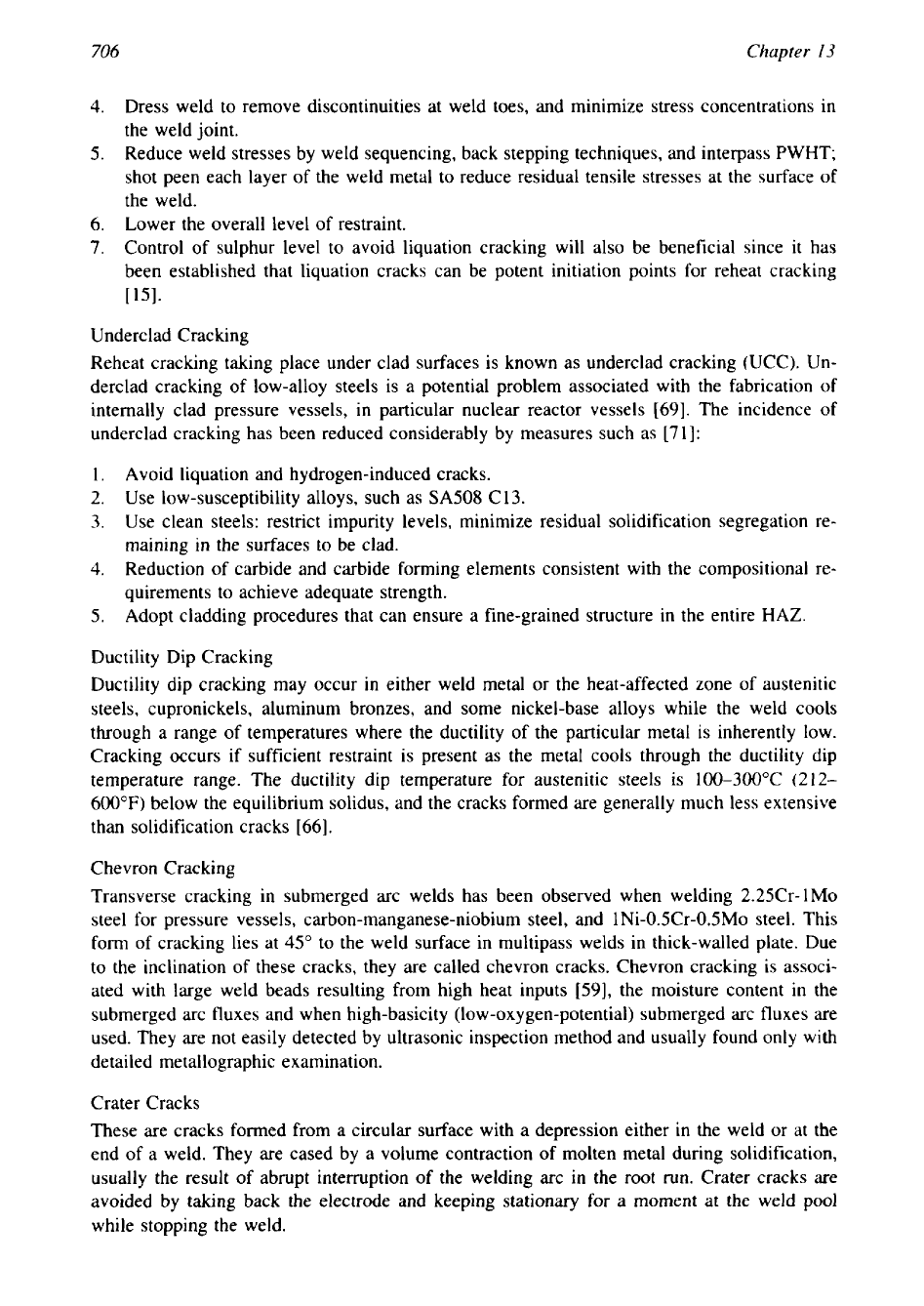
706
Chapter
13
4.
Dress weld to remove discontinuities at weld toes, and minimize stress concentrations in
the weld joint.
5.
Reduce weld stresses by weld sequencing, back stepping techniques, and interpass
PWHT;
shot peen each layer of the weld metal to reduce residual tensile stresses at the surface
of
the weld.
6.
Lower the overall level of restraint.
7.
Control of sulphur level to avoid liquation cracking will also be beneficial since
it
has
been established that liquation cracks can be potent initiation points for reheat cracking
~151.
Underclad Cracking
Reheat cracking taking place under clad surfaces is known as underclad cracking (UCC). Un-
derclad cracking of low-alloy steels is a potential problem associated with the fabrication
of
internally clad pressure vessels,
in
particular nuclear reactor vessels
[69].
The incidence
of
underclad cracking has been reduced considerably by measures such as
[71]:
1.
Avoid liquation and hydrogen-induced cracks.
2.
Use low-susceptibility alloys, such as SA508 C13.
3.
Use clean steels: restrict impurity levels, minimize residual solidification segregation re-
maining in the surfaces to be clad.
4.
Reduction of carbide and carbide forming elements consistent with the compositional re-
quirements to achieve adequate strength.
5.
Adopt cladding procedures that can ensure a fine-grained structure in the entire
HAZ.
Ductility Dip Cracking
Ductility dip cracking may occur in either weld metal or the heat-affected zone of austenitic
steels, cupronickels, aluminum bronzes, and some nickel-base alloys while the weld cools
through a range of temperatures where the ductility of the particular metal is inherently
low.
Cracking occurs if sufficient restraint is present as the metal cools through the ductility dip
temperature range. The ductility dip temperature for austenitic steels is 100-300°C
(2 12-
600°F)
below the equilibrium solidus, and the cracks formed are generally much less extensive
than solidification cracks
[66].
Chevron Cracking
Transverse cracking in submerged arc welds has been observed when welding 2.25Cr-
1
MO
steel for pressure vessels, carbon-manganese-niobium steel, and 1 Ni-O.5Cr-O.5Mo steel. This
form of cracking lies at
45"
to the weld surface in multipass welds in thick-walled plate. Due
to the inclination of these cracks, they are called chevron cracks. Chevron cracking is associ-
ated with large weld beads resulting from high heat inputs
[59],
the moisture content in the
submerged arc fluxes and when high-basicity (low-oxygen-potential) submerged arc fluxes are
used. They are not easily detected by ultrasonic inspection method and usually found only with
detailed metallographic examination.
Crater Cracks
These are cracks formed from a circular surface with a depression either in the weld or at the
end of a weld. They are cased by a volume contraction of molten metal during solidification,
usually the result of abrupt interruption of the welding arc in the root run. Crater cracks
are
avoided by taking back the electrode and keeping stationary for
a
moment at the weld pool
while stopping the weld.
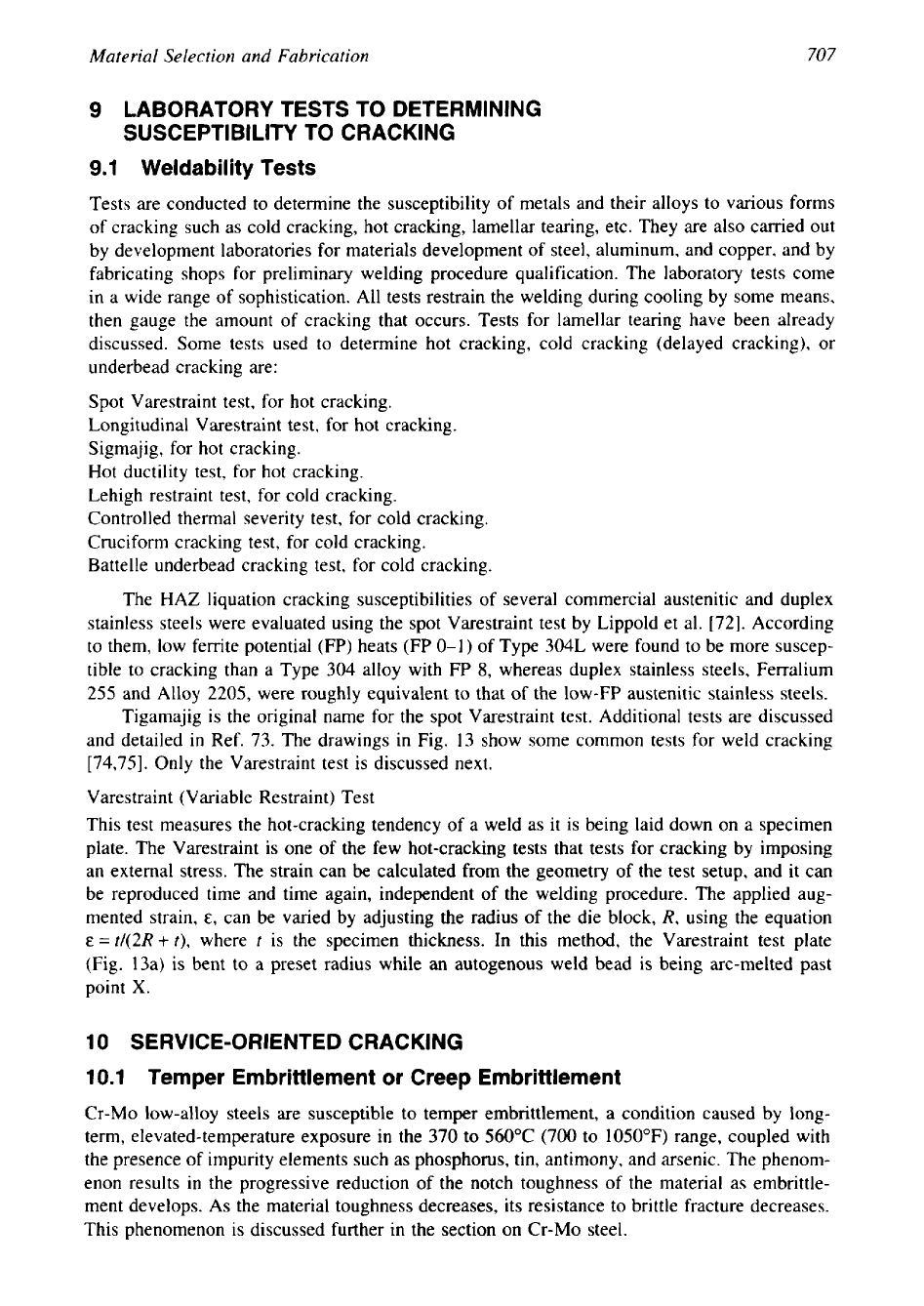
Material Selection and Fabrication
707
9
LABORATORY TESTS TO DETERMINING
SUSCEPTIBILITY TO CRACKING
9.1
Welda bility Tests
Tests are conducted to determine the susceptibility of metals and their alloys to various forms
of cracking such as cold cracking, hot cracking, lamellar tearing, etc. They are also carried out
by development laboratories for materials development of steel, aluminum, and copper, and by
fabricating shops for preliminary welding procedure qualification. The laboratory tests come
in a wide range
of
sophistication. All tests restrain the welding during cooling by some means,
then gauge the amount of cracking that occurs. Tests for lamellar tearing have been already
discussed. Some tests used to determine hot cracking, cold cracking (delayed cracking), or
underbead cracking are:
Spot Varestraint test, for hot cracking.
Longitudinal Varestraint test, for hot cracking.
Sigmajig, for hot cracking.
Hot ductility test, for hot cracking.
Lehigh restraint test, for cold cracking.
Controlled thermal severity test, for cold cracking.
Cruciform cracking test, for cold cracking.
Battelle underbead cracking test, for cold cracking.
The HAZ liquation cracking susceptibilities of several commercial austenitic and duplex
stainless steels were evaluated using the spot Varestraint test by Lippold et al. [72]. According
to them, low ferrite potential (FP) heats (FP 0-1) of Type 304L were found to be more suscep-
tible to cracking than a Type 304 alloy with FP
8,
whereas duplex stainless steels, Ferralium
255 and Alloy 2205, were roughly equivalent to that of the low-FP austenitic stainless steels.
Tigamajig is the original name for the spot Varestraint test. Additional tests are discussed
and detailed in Ref. 73. The drawings in Fig. 13 show some common tests for weld cracking
[74,75]. Only the Varestraint test is discussed next.
Varestraint (Variable Restraint) Test
This test measures the hot-cracking tendency of a weld as it is being laid down on a specimen
plate. The Varestraint is one of the few hot-cracking tests that tests for cracking by imposing
an external stress. The strain can be calculated
from
the geometry of the test setup, and it can
be reproduced time and time again, independent
of
the welding procedure. The applied aug-
mented strain,
E,
can be varied by adjusting the radius of the die block,
R,
using the equation
E
=
t/(2R+ t),
where
t
is the specimen thickness. In this method, the Varestraint test plate
(Fig. 13a) is bent to a preset radius while
an
autogenous weld bead is being arc-melted past
point
X.
10
SERVICE-ORIENTED CRACKING
10.1
Temper Embrittlement or Creep Embrittlement
Cr-Mo low-alloy steels are susceptible to temper embrittlement, a condition caused by long-
term, elevated-temperature exposure in the
370
to
560°C
(700 to 1050°F) range, coupled with
the presence
of
impurity elements such as phosphorus, tin, antimony, and arsenic. The phenom-
enon results in the progressive reduction of the notch toughness of the material as embrittle-
ment develops. As the material toughness decreases, its resistance to brittle fracture decreases.
This phenomenon is discussed further in the section on Cr-Mo steel.
Material Selection and Fabrication
707
9
LABORATORY TESTS TO DETERMINING
SUSCEPTIBILITY TO CRACKING
9.1
Welda bility Tests
Tests are conducted to determine the susceptibility of metals and their alloys to various forms
of cracking such as cold cracking, hot cracking, lamellar tearing, etc. They are also carried out
by development laboratories for materials development of steel, aluminum, and copper, and by
fabricating shops for preliminary welding procedure qualification. The laboratory tests come
in a wide range
of
sophistication. All tests restrain the welding during cooling by some means,
then gauge the amount of cracking that occurs. Tests for lamellar tearing have been already
discussed. Some tests used to determine hot cracking, cold cracking (delayed cracking), or
underbead cracking are:
Spot Varestraint test, for hot cracking.
Longitudinal Varestraint test, for hot cracking.
Sigmajig, for hot cracking.
Hot ductility test, for hot cracking.
Lehigh restraint test, for cold cracking.
Controlled thermal severity test, for cold cracking.
Cruciform cracking test, for cold cracking.
Battelle underbead cracking test, for cold cracking.
The HAZ liquation cracking susceptibilities of several commercial austenitic and duplex
stainless steels were evaluated using the spot Varestraint test by Lippold et al. [72]. According
to them, low ferrite potential (FP) heats (FP 0-1) of Type 304L were found to be more suscep-
tible to cracking than a Type 304 alloy with FP
8,
whereas duplex stainless steels, Ferralium
255 and Alloy 2205, were roughly equivalent to that of the low-FP austenitic stainless steels.
Tigamajig is the original name for the spot Varestraint test. Additional tests are discussed
and detailed in Ref. 73. The drawings in Fig. 13 show some common tests for weld cracking
[74,75]. Only the Varestraint test is discussed next.
Varestraint (Variable Restraint) Test
This test measures the hot-cracking tendency of a weld as it is being laid down on a specimen
plate. The Varestraint is one of the few hot-cracking tests that tests for cracking by imposing
an external stress. The strain can be calculated
from
the geometry of the test setup, and it can
be reproduced time and time again, independent
of
the welding procedure. The applied aug-
mented strain,
E,
can be varied by adjusting the radius of the die block,
R,
using the equation
E
=
t/(2R+ t),
where
t
is the specimen thickness. In this method, the Varestraint test plate
(Fig. 13a) is bent to a preset radius while
an
autogenous weld bead is being arc-melted past
point
X.
10
SERVICE-ORIENTED CRACKING
10.1
Temper Embrittlement or Creep Embrittlement
Cr-Mo low-alloy steels are susceptible to temper embrittlement, a condition caused by long-
term, elevated-temperature exposure in the
370
to
560°C
(700
to 1050°F) range, coupled with
the presence
of
impurity elements such as phosphorus, tin, antimony, and arsenic. The phenom-
enon results in the progressive reduction of the notch toughness of the material as embrittle-
ment develops. As the material toughness decreases, its resistance to brittle fracture decreases.
This phenomenon is discussed further in the section on Cr-Mo steel.
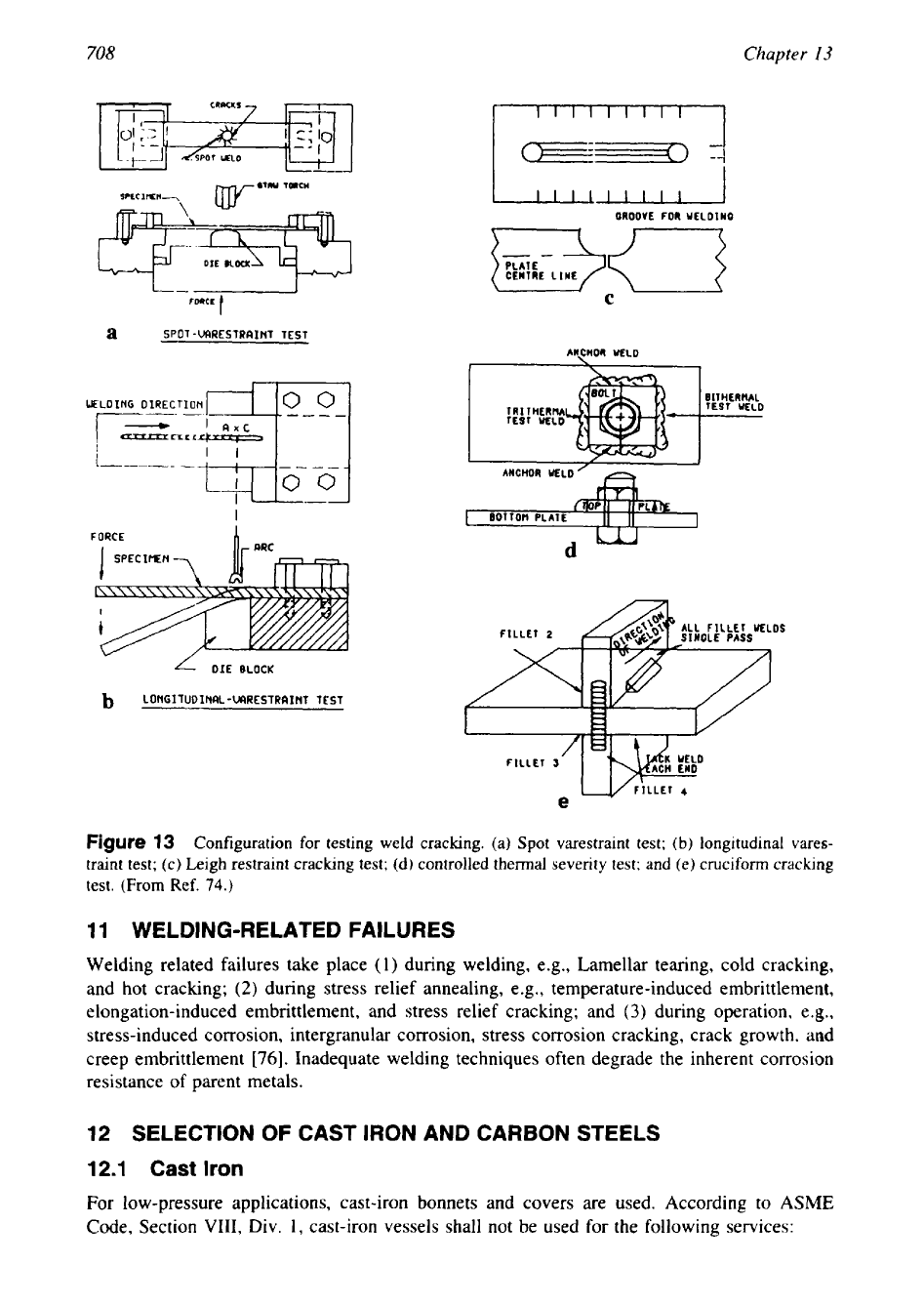
708
Chapter
I3
OROOVE
FOR
WELOINO
F+<-{
CENTRE
LINE
C
ANCHOR
WELD
t
BllHERHAL
TRITHERBA
TEST
WELD
TEST
WELD
ANCHOR WELD’
P f
1
3
I,
I
I
111oPIl
BOTTOB
PLATE
I
IIPL&
II
FORCE
I
n,
ARC
d’
DIE
BLOCK
b
LONGITUDINAL-UARESTRAInT TEST
Figure
13
Configuration for testing weld cracking. (a)
Spot
varestraint test;
(b)
longitudinal vares-
traint test; (c) Leigh restraint cracking test;
(d)
controlled thermal severity test; and (e) cruciform cracking
test.
(From
Ref.
74.)
1
1
WELDING-RELATED FAILURES
Welding related failures take place
(1)
during welding, e.g., Lamellar tearing, cold cracking,
and hot cracking;
(2)
during stress relief annealing, e.g., temperature-induced embrittlement,
elongation-induced embrittlement, and stress relief cracking; and
(3)
during operation, e.g.,
stress-induced corrosion, intergranular corrosion, stress corrosion cracking, crack growth, and
creep embrittlement
[76].
Inadequate welding techniques often degrade the inherent corrosion
resistance of parent metals.
12
SELECTION OF CAST IRON AND CARBON STEELS
12.1
Cast
Iron
For low-pressure applications, cast-iron bonnets and covers are used. According to
ASME
Code, Section
VIII,
Div.
1,
cast-iron vessels shall not be used for the following services:

Material Selection and Fabrication
709
To
contain lethal or flammable substances, either liquid or gases.
For unfired steam boilers.
For direct firing.
The design pressure and temperature limitations for the vessels and the vessel parts constructed
of cast iron are listed in ASME Code Section VIII, Div. 1, UCI-3.
12.2
Steels
Grades of steel may
vary
in chemical composition from almost pure iron to a material of
complex composition made up of several elements. Widely dissimilar properties and qualities
may be obtained from a carbon steel within specified chemical limits of a given grade by
changes in steel making and mill processing. In selection of the proper quality within a given
grade, the end use and method of fabrication should be considered. Various practices are
employed in all phases of steel production which determine the type and quality of the finished
product.
Carbon steel
is steel for which no minimum content is specified or required for alloying
elements such as, chromium, cobalt, columbium, molybdenum, nickel, titanium, tungsten, va-
nadium, or zirconium, or any other element added to obtain a desired effect; when the specified
minimum for copper does not exceed 0.40%; or when the maximum content specified for any
of the following elements does not exceed the percentages noted: manganese 1.65, silicon 0.60,
and copper
0.60.
Carbon steel depends on carbon and manganese in conjunction with proper
processing to improve mechanical properties
High-strength low-alloy
(HSLA)
steel
comprises a group of steels with chemical composi-
tion specially developed to impart higher values of mechanical properties-in certain of these
steels, greater resistance to atmospheric corrosion than is obtainable from conventional carbon
structural steels. It is not considered to be alloy steel, even though an intentionally added alloy
would qualify it as such. The minimum yield point and tensile strength requirements most
often specified are
42
to
80
ksi (290 to
550
MPa) yield point and
60
to 90 ksi (415 to 620
MPa) tensile strength. These steels achieve high strength, high toughness, good formability
,
and good weldability.
Low-alloy steels
are divided into groups according to their chemical composition, i.e.,
molybdenum alloy steel, manganese-molybdenum-nickel alloy steel, and chromium-molybde-
num alloy steel, and each group is further divided according to strength level. Steels are com-
mercially classified as low-alloy steels when they have:
1. Manganese content exceeding 1.65%,
2. Silicon content exceeding 0.60%.
3.
Copper content in excess of 0.60%.
4.
A
range or a minimum amount of any other alloying element such as nickel, molybdenum,
vanadium, chromium, etc. specified or added to obtain any alloying effect.
Alloy steels can utilize
a
wide variety of alloying elements and heat treatments to develop the
most desirable combination
of
properties.
Process Improvements
Steel making has undergone considerable change in the last
25
years, resulting in various steels
with changes in properties of the end product. Improved refining techniques, vacuum induction
melting technique (VIM), low-sulfur steel-making methods, refining processes such as argon-
oxygen decarburization (AOD), and vacuum oxygen decarburization
(VOD),
electroslag re-
melting, ladle metallurgy, vacuum degassing, pressure casting, continuous casting, controlled
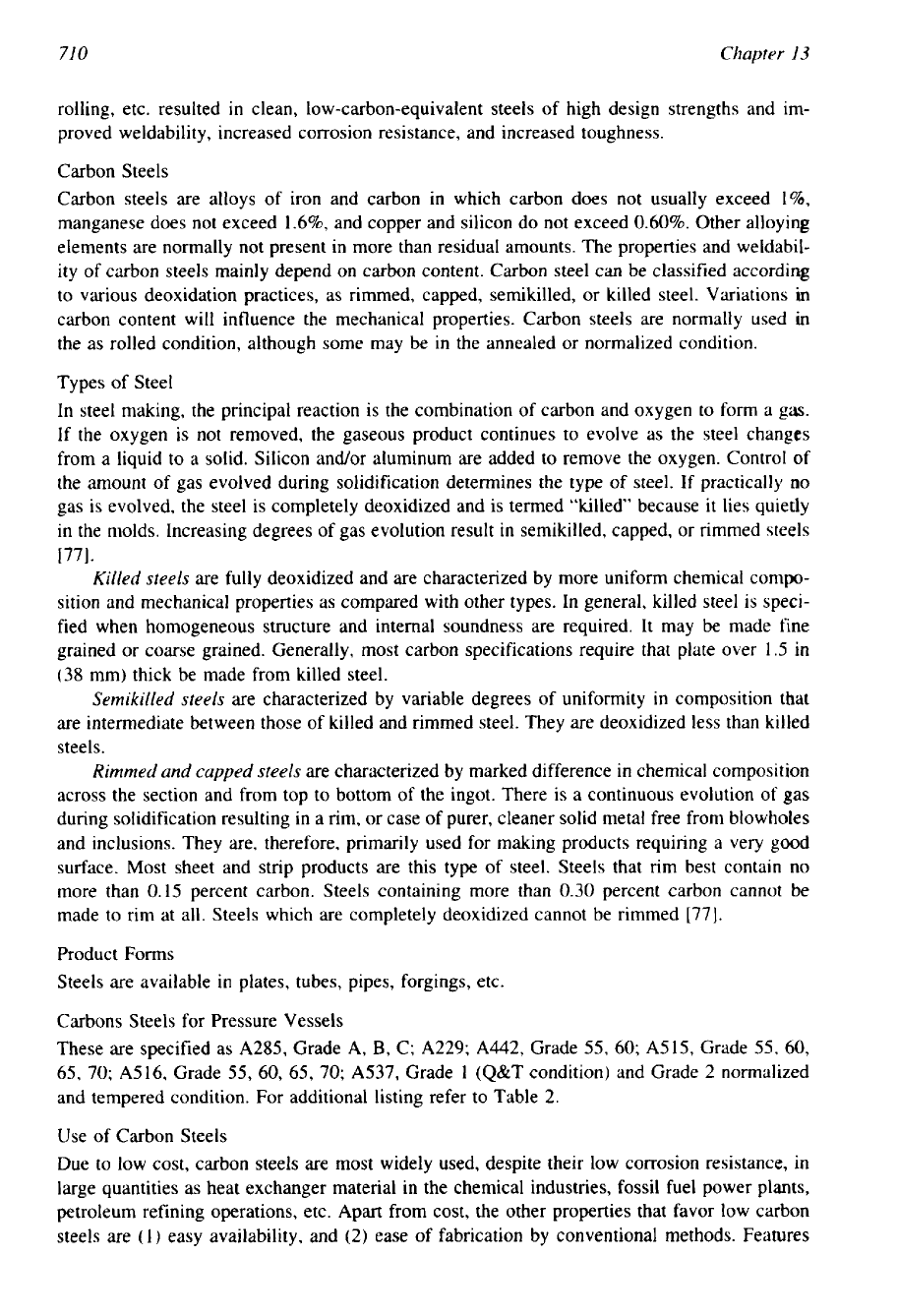
71
0
Chapter
13
rolling, etc. resulted in clean, low-carbon-equivalent steels of high design strengths and im-
proved weldability, increased corrosion resistance, and increased toughness.
Carbon Steels
Carbon steels are alloys of iron and carbon in which carbon does not usually exceed 196,
manganese does not exceed 1.6%. and copper and silicon do not exceed
0.60%.
Other alloying
elements are normally not present in more than residual amounts. The properties and weldabil-
ity of carbon steels mainly depend on carbon content. Carbon steel can be classified according
to various deoxidation practices, as rimmed, capped, semikilled, or killed steel. Variations
in
carbon content will influence the mechanical properties. Carbon steels are normally used
in
the as rolled condition, although some may be in the annealed or normalized condition.
Types of Steel
In steel making, the principal reaction is the combination of carbon and oxygen to form a
gas.
If
the oxygen is not removed, the gaseous product continues to evolve as the steel changes
from a liquid to a solid. Silicon andor aluminum are added to remove the oxygen. Control of
the amount of gas evolved during solidification determines the type of steel. If practically
no
gas is evolved, the steel is completely deoxidized and
is
termed “killed’ because it lies quietly
in the molds. Increasing degrees of gas evolution result in semikilled, capped, or rimmed steels
[771.
Killed steels
are fully deoxidized and are characterized by more uniform chemical compo-
sition and mechanical properties as compared with other types. In general, killed steel is speci-
fied when homogeneous structure and internal soundness are required. It may be made fine
grained or coarse grained. Generally, most carbon specifications require that plate over
1.5
in
(38
mm) thick be made from killed steel.
Semikilled steels
are characterized by variable degrees of uniformity in composition that
are intermediate between those of killed and rimmed steel. They are deoxidized less than killed
steels.
Rimmed and capped
steels
are characterized by marked difference
in
chemical composition
across the section and from top to bottom of the ingot. There is a continuous evolution of gas
during solidification resulting in a rim, or case of purer, cleaner solid metal free from blowholes
and inclusions. They are, therefore, primarily used for making products requiring a very good
surface. Most sheet and strip products are this type of steel. Steels that rim best contain no
more than 0.15 percent carbon. Steels containing more than
0.30
percent carbon cannot be
made to rim at all. Steels which are completely deoxidized cannot be rimmed
[77].
Product Forms
Steels are available in plates, tubes, pipes, forgings, etc.
Carbons Steels for Pressure Vessels
These are specified as
A285,
Grade
A,
B,
C;
A229; A442,
Grade
55,
60;
A515,
Grade 55, 60,
65,
70;
A516,
Grade
55,
60, 65,
70;
A537,
Grade
1
(Q&T
condition) and Grade
2
normalized
and tempered condition. For additional listing refer to Table
2.
Use of Carbon Steels
Due to low cost, carbon steels are most widely used, despite their low corrosion resistance, in
large quantities as heat exchanger material in the chemical industries, fossil fuel power plants,
petroleum refining operations, etc.
Apart
from cost, the other properties that favor low carbon
steels are
(1)
easy availability, and
(2)
ease of fabrication by conventional methods. Features
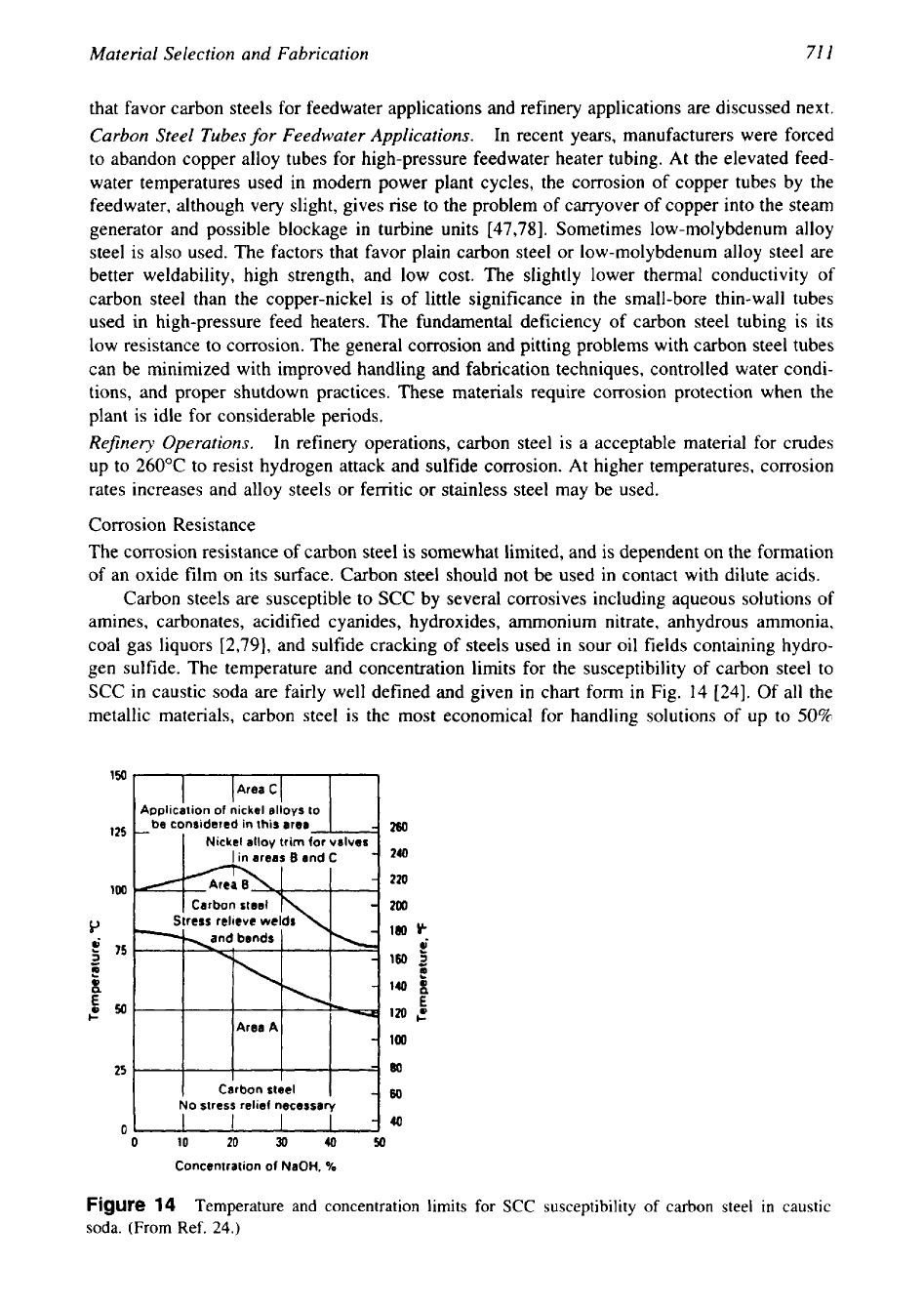
Material Selection and Fabrication
71
I
that favor carbon steels for feedwater applications and refinery applications are discussed next.
Carbon Steel Tubes
for
Feedwater Applications.
In recent years, manufacturers were forced
to abandon copper alloy tubes for high-pressure feedwater heater tubing. At the elevated feed-
water temperatures used in modem power plant cycles, the corrosion of copper tubes by the
feedwater, although very slight, gives rise to the problem of carryover of copper into the steam
generator and possible blockage in turbine units [47,78]. Sometimes low-molybdenum alloy
steel is also used. The factors that favor plain carbon steel or low-molybdenum alloy steel are
better weldability, high strength, and low cost. The slightly lower thermal conductivity of
carbon steel than the copper-nickel is of little significance in the small-bore thin-wall tubes
used in high-pressure feed heaters. The fundamental deficiency of carbon steel tubing is its
low resistance to corrosion. The general corrosion and pitting problems with carbon steel tubes
can be minimized with improved handling and fabrication techniques, controlled water condi-
tions, and proper shutdown practices. These materials require corrosion protection when the
plant is idle for considerable periods.
Refinery Operations.
In refinery operations, carbon steel is a acceptable material for crudes
up to 260°C to resist hydrogen attack and sulfide corrosion. At higher temperatures, corrosion
rates increases and alloy steels or ferritic or stainless steel may be used.
Corrosion Resistance
The corrosion resistance of carbon steel is somewhat limited, and is dependent on the formation
of an oxide film on its surface. Carbon steel should not be used in contact with dilute acids.
Carbon steels are susceptible to SCC by several corrosives including aqueous solutions of
amines, carbonates, acidified cyanides, hydroxides, ammonium nitrate, anhydrous ammonia,
coal gas liquors [2,79], and sulfide cracking
of
steels used in sour oil fields containing hydro-
gen sulfide. The temperature and concentration limits for the susceptibility of carbon steel to
SCC in caustic soda are fairly well defined and given in chart form in Fig.
14
[24].
Of all the
metallic materials, carbon steel is the most economical for handling solutions of up to
50%
150
lAreaCI
I
I
I
ADDiicalion
of
nickel
allovs
to
-
be considered
in
this
aka
260
125
-4
I
Nickel
alloy
trim
for
vslvss
240
220
100
200
Y
ress
relieve
we1
180
b"
-
$
75
f
160
3
E
t
E"
140
E
im
100
25
80
60
No
stress relief necessary
C
I l l 1
4Q
I
10
20
30
40
50
Concentration
of
NaOH,
%
Figure
14
Temperature and concentration limits
for
SCC
susceptibility
of
carbon steel in caustic
soda.
(From
Ref.
24.)
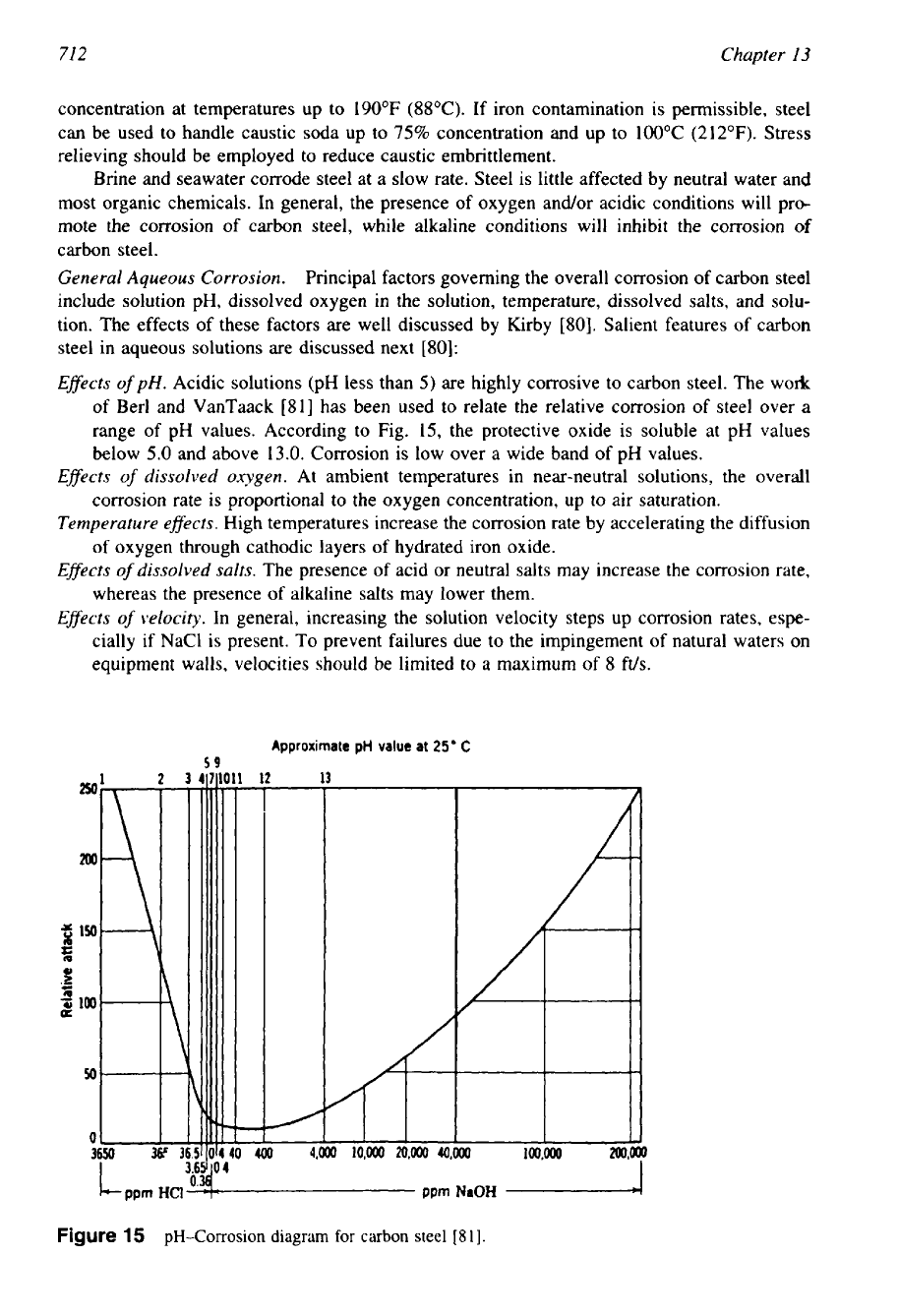
71
2
Chapter
13
concentration at temperatures up to
190°F
(88°C).
If iron contamination
is
permissible, steel
can be used to handle caustic soda up to
75%
concentration and up to 100°C (212°F). Stress
relieving should be employed to reduce caustic embrittlement.
Brine and seawater corrode steel at a slow rate. Steel is little affected by neutral water and
most organic chemicals. In general, the presence of oxygen and/or acidic conditions will proc
mote the corrosion
of
carbon steel, while alkaline conditions will inhibit the corrosion
of
carbon steel.
General Aqueous
Corrosion.
Principal factors governing the overall corrosion of carbon steel
include solution pH, dissolved oxygen in the solution, temperature, dissolved salts, and solu-
tion. The effects of these factors are well discussed by Kirby
[80].
Salient features of carbon
steel in aqueous solutions are discussed next
[80]:
EJffects
of
pH.
Acidic solutions (pH less than
5)
are highly corrosive to carbon steel. The work
of
Berl and VanTaack
[81]
has been used to relate the relative corrosion
of
steel over a
range of pH values. According to Fig.
15,
the protective oxide is soluble at pH values
below
5.0
and above
13.0.
Corrosion is low over a wide band of pH values.
Effects
of
dissolved oxygen.
At ambient temperatures in near-neutral solutions, the overall
corrosion rate is proportional to the oxygen concentration, up to air saturation.
Temperature efects.
High temperatures increase the corrosion rate by accelerating the diffusion
of
oxygen through cathodic layers of hydrated iron oxide.
Efsects
of
dissolved salts.
The presence
of
acid or neutral salts may increase the corrosion rate,
whereas the presence of alkaline salts may lower them.
EfSects
of
velocity.
In general, increasing the solution velocity steps up corrosion rates, espe-
cially if NaCl is present.
To
prevent failures due to the impingement of natural waters on
equipment walls, velocities should be limited to a maximum
of
8
ft/s.
Approximate
pH
value
at
25"
C
59
12
13
50-
I
0,
3650
36F
3
4,000
10,ooO
20,000
40,000
100,ooo
200,o
ppm
NaOH
I
Figure
15
pH-Corrosion
diagram
for
carbon
steel
[81].
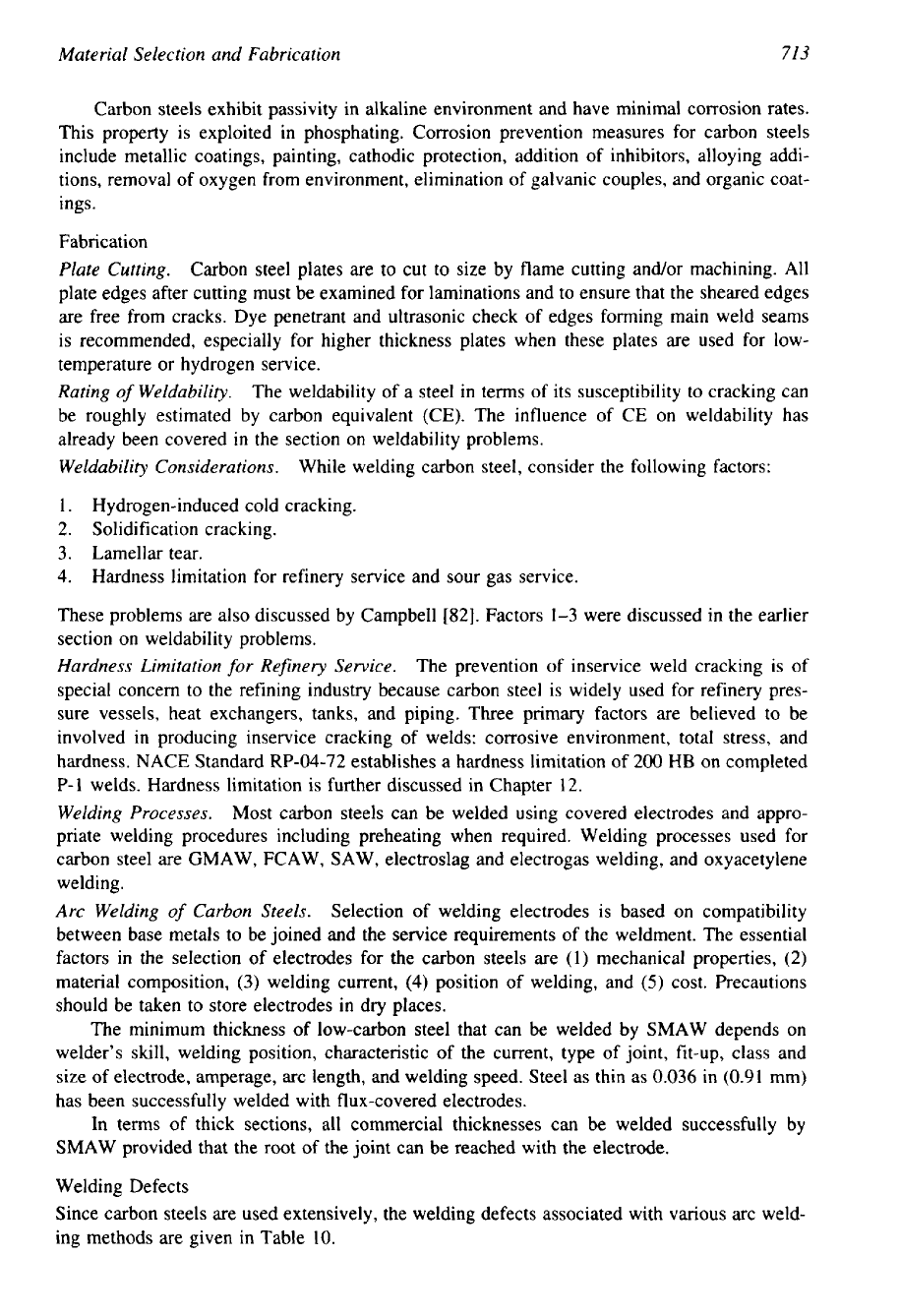
Material Selection and Fabrication
71
3
Carbon steels exhibit passivity in alkaline environment and have minimal corrosion rates.
This property is exploited
in
phosphating. Corrosion prevention measures for carbon steels
include metallic coatings, painting, cathodic protection, addition of inhibitors, alloying addi-
tions, removal of oxygen from environment, elimination of galvanic couples, and organic coat-
ings.
Fabrication
Plate Cutting.
Carbon steel plates are to cut to size by flame cutting andor machining. All
plate edges after cutting must be examined for laminations and to ensure that the sheared edges
are free from cracks. Dye penetrant and ultrasonic check of edges forming main weld seams
is recommended, especially for higher thickness plates when these plates are used for low-
temperature or hydrogen service.
Rating
of
Weldability.
The weldability of a steel in terms of its susceptibility to cracking can
be roughly estimated by carbon equivalent
(CE).
The influence
of
CE on weldability has
already been covered in the section on weldability problems.
Weldability Considerations.
While welding carbon steel, consider the following factors:
1. Hydrogen-induced cold cracking.
2. Solidification cracking.
3.
Lamellar tear.
4. Hardness limitation for refinery service and sour gas service.
These problems are also discussed by Campbell [82]. Factors
1-3
were discussed in the earlier
section on weldability problems.
Hardness Limitation
for
Refinery Service.
The prevention of inservice weld cracking is of
special concern to the refining industry because carbon steel is widely used for refinery pres-
sure vessels, heat exchangers, tanks, and piping. Three primary factors are believed to be
involved in producing inservice cracking of welds: corrosive environment, total stress, and
hardness. NACE Standard RP-04-72 establishes a hardness limitation of 200
HB
on completed
P-1 welds. Hardness limitation is further discussed in Chapter 12.
Welding Processes.
Most carbon steels can be welded using covered electrodes and appro-
priate welding procedures including preheating when required. Welding processes used for
carbon steel are GMAW, FCAW, SAW, electroslag and electrogas welding, and oxyacetylene
welding.
Arc
Welding
of
Carbon Steels.
Selection
of
welding electrodes
is
based on compatibility
between base metals to be joined and the service requirements of the weldment. The essential
factors in the selection of electrodes for the carbon steels are (1) mechanical properties,
(2)
material composition,
(3)
welding current,
(4)
position of welding, and
(5)
cost. Precautions
should be taken to store electrodes in dry places.
The minimum thickness of low-carbon steel that can be welded by SMAW depends on
welder’s skill, welding position, characteristic of the current, type
of
joint, fit-up, class and
size of electrode, amperage, arc length, and welding speed. Steel as thin
as
0.036
in
(0.91
mm)
has been successfully welded with flux-covered electrodes.
In terms
of
thick sections, all commercial thicknesses can be welded successfully by
SMAW provided that the root of the joint can be reached with the electrode.
Welding Defects
Since carbon steels are used extensively, the welding defects associated with various arc weld-
ing methods are given in Table 10.
